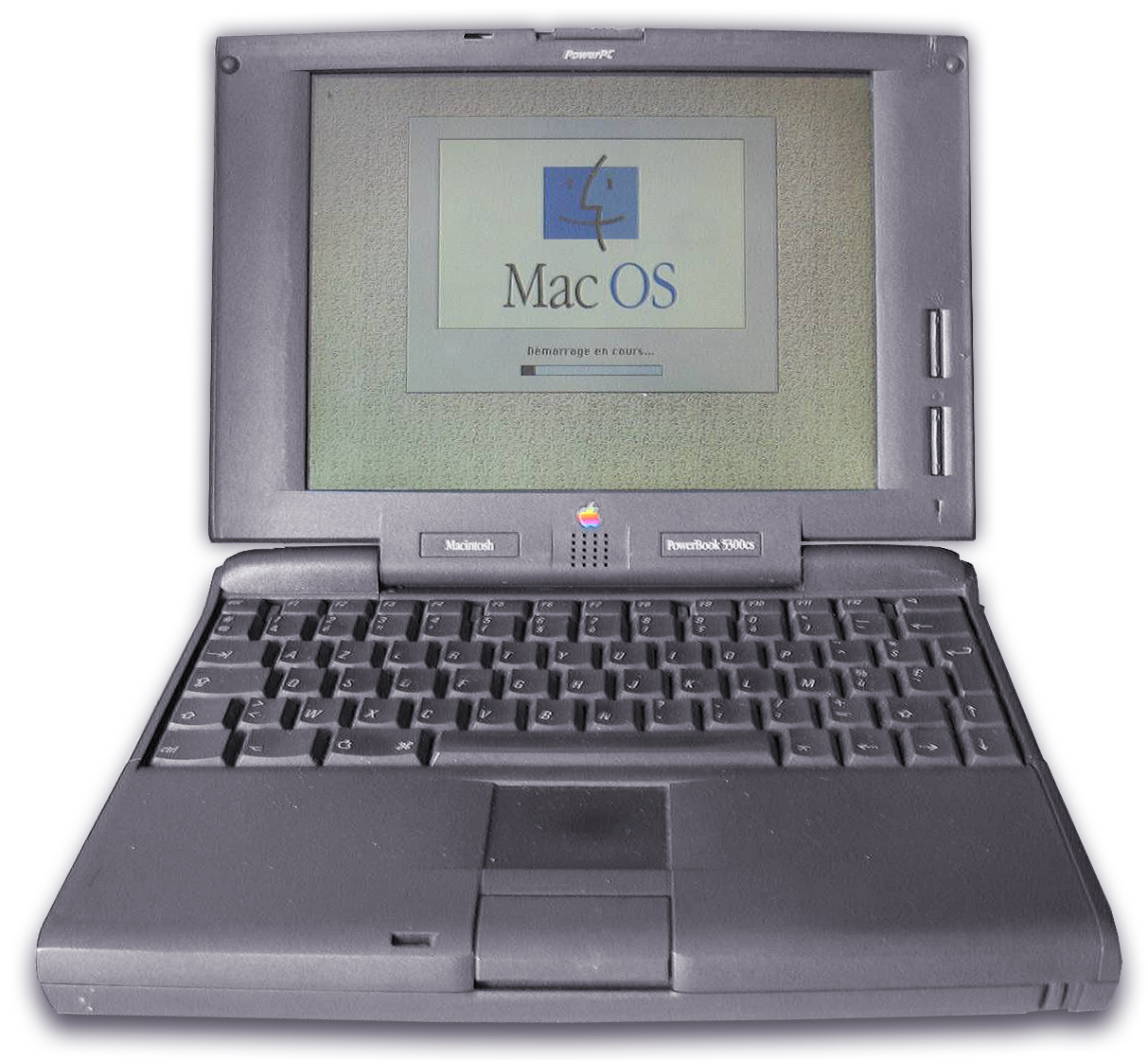- PowerBook 5300
240px
Introduced=August 25 1995
MSRP=2300 - 6800
CPU=PowerPC 603e
CPUspeed=100 - 117 MHz
OS=System 7.5.2
RAM=8MiB , expandable to 64 MiB
RAMtype=70 ns unique DRAM card
Discontinued=August 3 ,1996 The PowerBook 5300 series was the first generation ofPowerBook laptop s manufactured byApple Computer to use thePowerPC processor. Released in August 1995, these PowerBooks were notable for being the first to feature hot-swappable expansion modules for a variety of different units such asZIP drive s;PC card slots as standard; and aninfrared communication port.Paul Kunkel & Rick English, "Apple Design" pp 260-261, Graphis. ISBN 1-8880-0125-9.] In common with most preceding Macintosh portables,SCSI , Serial, and ADB ports were available as standard. An internal expansion slot was also available for installing a variety of modules includingEthernet andvideo card s to drive a second monitor in mirroring or dual-screen modes.Although a significant advance over preceding portable Macs, it is quite common to see the PowerBook 5300 series listed as among the worst Apple products of all time.lowendmac.com: [http://lowendmac.com/roadapples/5300.shtml Road Apples: PowerBook 5300] ]
Specifications
There were four models in the 5300 series, ranging from the low-end
greyscale 5300 to the deluxe high resolution TFT-equipped 5300ce:Design
The PowerBook 5300 was designed during 1993 and 1994 under the codename M2. Compared with the preceding
PowerBook 500 series, the 5300 was explicitly designed to be as small as possible (which precluded the use of a CD-ROM drive) and featured a more compact but less curvy design. Pop-out feet were used instead of the rotating rocker-style feet typical of earlier PowerBooks, and a slightly darker shade of grey was used for the plastic casing.Paul Kunkel & Rick English, "Apple Design" pp 260-261, Graphis. ISBN 1-8880-0125-9.] ThePowerBook 190 used an identical casing and shared many features and internal components, but used the older and slowerMotorola 68LC040 processor instead, which could be upgraded to a full PPC processor. Likewise, thePowerBook 150 could be considered the low-end of the 5300 line, sporting many of the same internals running an even more datedMotorola 68030 processor in a 100 Series case.Problems
For a variety of reasons, the PowerBook 5300 series has been viewed as a disappointment. Problems with cracked cases and overheating batteries prompted several recalls,Owen Linzmayer, "Apple Confidential" p 237, No Starch Press. ISBN 1-5632-7010-0] while some users were simply unimpressed with the specifications of the machine and its lackluster performance.lowendmac.com: [http://lowendmac.com/roadapples/5300.shtml Road Apples: PowerBook 5300] ]
Lack of L2 cache
Although the
PowerPC 603e processor built into the 5300 series was relatively fast for its time, because these machines lacked aLevel 2 cache , real world performance was much less than the CPU frequency would suggest.lowendmac.com: [http://lowendmac.com/roadapples/5300.shtml Road Apples: PowerBook 5300] ]Expansion bay options
The variety of expansion bay options available was wide, but because of the size and shape of the computer, fitting a CD-ROM drive into the available space wasn't possible.Paul Kunkel & Rick English, "Apple Design" pp 260-261, Graphis. ISBN 1-8880-0125-9.] Apple had a prototype CD-ROM module compatible with
non-standard 80 mm disks that would have been used with the PowerBook 5300 series, but finished versions of this device were never released.Fact|date=March 2008 Instead, it was planned that the 5300 series would use 3.5 inchmagneto-optical drive modules initially, with the option of releasing a stretched version a year or two later that had space for a full-sized CD-ROM drive.Paul Kunkel & Rick English, "Apple Design" pp 260-261, Graphis. ISBN 1-8880-0125-9.]Batteries
Two early production PowerBook 5300s caught fire, one at an Apple employee's house and another at the factory; it turned out that the
Sony manufactured lithium ion batteries had overheated while recharging. Apple recalled the 5300s sold (around a hundred machines) and replaced the batteries on these and all subsequent 5300s with nickel metal hydride batteries that provided only about 70% the endurance. At the time, the media viewed the problems with the PowerBook 5300 series as yet another example of Apple's decline.Owen Linzmayer, "Apple Confidential" p 237, No Starch Press. ISBN 1-5632-7010-0]Legacy
Apple's next high-end series of portables, the
PowerBook 3400 series introduced in February 1997, shared an almost identicalform factor with the 5300, right down to being able to share many of the same hot-swappable expansion modules. On the other hand, the 3400 series were substantially different machines on the inside, featuring things like DMA and PCI architecture.Paul Kunkel & Rick English, "Apple Design" pp 265-267, Graphis. ISBN 1-8880-0125-9.] The first series of PowerBook G3 portables released in November 1997 were internally even more advanced, being built around thePowerPC G3 processor, though they still retained the basic PowerBook 5300 form factor. Apple did not introduce portables with an entirely new form factor until March 1998 with the release of the "Wallstreet" G3 PowerBooks.References
External links
* Apple's datasheets: [http://docs.info.apple.com/article.html?artnum=112325 5300] , [http://docs.info.apple.com/article.html?artnum=112326 5300cs] , [http://docs.info.apple.com/article.html?artnum=112327 5300c] , [http://docs.info.apple.com/article.html?artnum=112328 5300ce] Navbox with columns
name = Navbox with columns/doc
state = uncollapsed
title = Apple Model Navigation
colstyle = text-align:center;background:silver;
colwidth = 25%
col1header = Replaced
col2header = Current Model
col3header = Successor
col1 =PowerBook 500 series
col2 =PowerBook 5300
col3 =PowerBook 3400c
col1footer = Preceding Family Model
col2footer =August 25 ,1995
col3footer = Following Family Model
Wikimedia Foundation. 2010.

